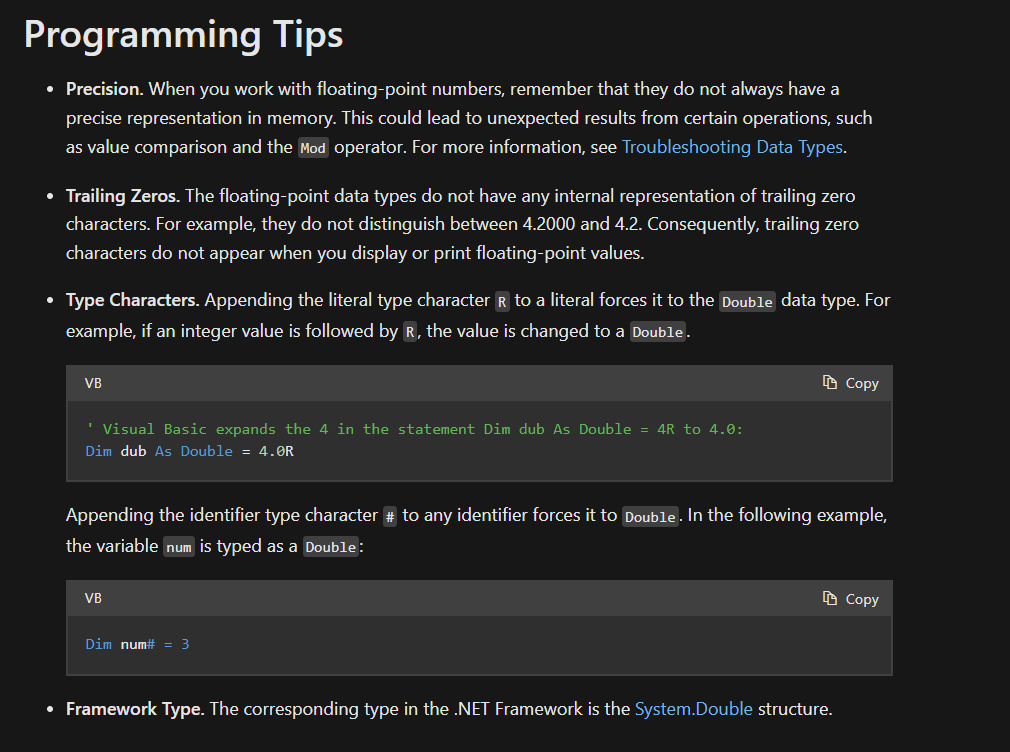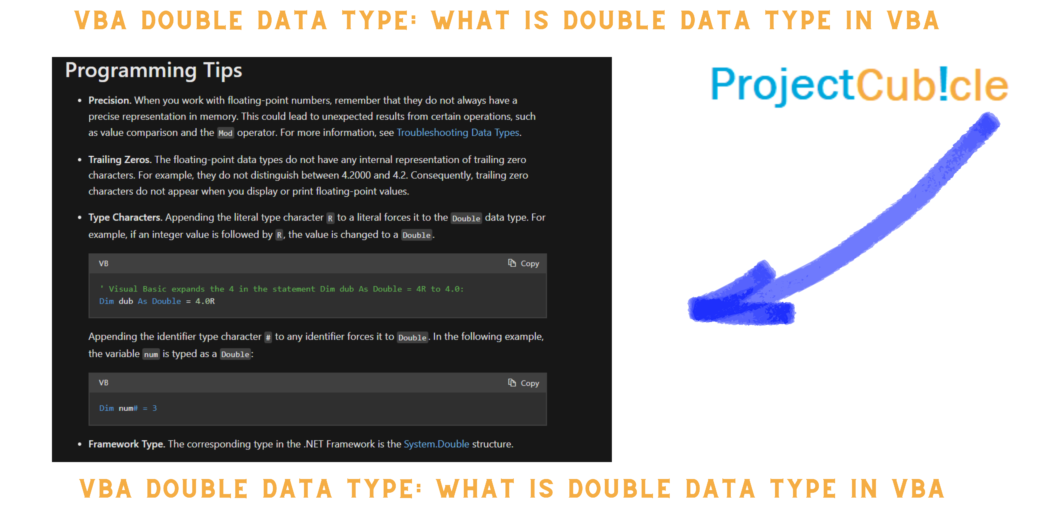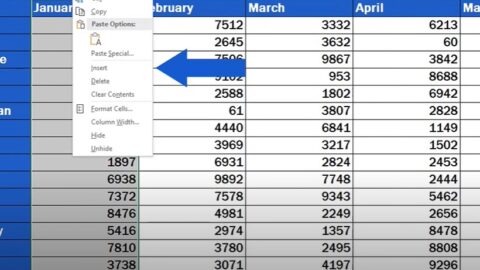VBA DOUBLE DATA TYPE: What is Double Data Type in VBA
What is Double Data Type in VBA? In Visual Basic for Applications, what does it imply to use the Double Data Type (excel vba double data type)? It is very necessary to have the Double data type in Visual Basic for Applications (VBA) in order to effectively manage numerical data management. The Visual Basic for Applications (VBA) programming language has a variety of data types, which allows it to manage a wide variety of data kinds. When it comes to dealing with numbers that need a high degree of accuracy, the Double data type is considered to be particularly beneficial.
Table of Contents
Delving into the Characteristics of Double Data Type
The Double data type in VBA is a numeric data type that can hold double-precision floating-point numbers. In light of this, it is clear that it is able to store numbers that are either exceedingly big or extremely small with a high degree of accuracy in any of these two extremes. By using this approach, the accuracy of the Single data type, which is another numeric data type in Visual Basic for Applications, is essentially raised by a factor of two. This particular data type is used in Visual Basic for Applications.
VBA Series: How do I use array in Excel VBA? – projectcubicle
Understanding Precision and Range
One of the key characteristics of the Double data type is its ability to maintain precision over a wide range of values. The ability of the Double data type to keep its accuracy across a broad range of values is considered to be one of the most important characteristics that it has. This is because it allows the data type to store a large number of values. In contrast to other data types, which may experience a loss of precision when working with numbers that are either very big or extremely tiny, the Double data type excels in retaining accuracy throughout a wide range of numeric values. This may be the case when dealing with numbers that are either extremely large or extremely small. This is due to the fact that the Double data type is capable of managing values that are either exceedingly huge or extremely little.

VBA DOUBLE DATA TYPE
Exploring Common Uses of the Double Data Type
The Double data type stands as a fundamental tool across various sectors, including finance, engineering, and scientific research, owing to its unparalleled capacity to handle extensive datasets and execute intricate calculations effectively. It effortlessly manages both immensely large and infinitesimally small numerical values with precision, mitigating common challenges such as rounding errors to enhance the accuracy of computations.
In finance, where precision is paramount, the Double data type ensures meticulousness in computations, from interest rates to investment portfolios. Similarly, in engineering, it plays a pivotal role in determining load capacities and simulating complex systems, upholding the accuracy of analyses. In scientific research, the Double data type empowers researchers to navigate vast datasets and execute precise numerical computations, whether modeling climate patterns, simulating molecular interactions, or analyzing astronomical phenomena. Its versatility and reliability make it indispensable in driving innovation and progress across diverse fields.
Benefits of Using the Double Data Type
One of the primary benefits of using the Double data type is its ability to handle a wide range of numeric values with precision. Whether dealing with very large numbers such as astronomical figures or very small numbers such as molecular sizes, the Double data type ensures that calculations are accurate.
Understanding the Syntax for Declaring Double Variables
In VBA, declaring a variable of the data is straightforward. You simply use the Dim keyword followed by the variable name and the As Double declaration. For example:
Dim myNumber As Double
Excel VBA Double Data Type and its Significance
Excel VBA leverages the DDT extensively for numerical computations within spreadsheets. Whether it’s performing complex calculations or analyzing large datasets, Excel VBA relies on the precision and flexibility offered by the DDT to ensure accurate results.
Access VBA Double Data Type and its Application
Similarly, Access VBA utilizes the Double data type for handling numeric data in databases. Whether it’s managing inventory levels or calculating financial metrics, Access VBA benefits from the precision and versatility of the Double data type to streamline data processing tasks.
Exploring Data Type VBA Double for Varied Applications
The Data Type VBA Double combination underscores the flexibility and utility of the Excel across different VBA environments. Whether it’s in Excel, Access, or other VBA applications, the Double data type proves to be an essential tool for handling numeric data with precision and efficiency.
Conclusion
In conclusion, the Double data type in Excel is a versatile and powerful tool for handling numeric data with precision and accuracy. Whether it’s crunching numbers in financial applications, engineering calculations, or scientific research, the Double data type proves to be an invaluable asset. Mastering the DDT opens up a world of possibilities in VBA programming, enabling developers to tackle complex numerical tasks with confidence and efficiency.
Hello, I’m Cansu, a professional dedicated to creating Excel tutorials, specifically catering to the needs of B2B professionals. With a passion for data analysis and a deep understanding of Microsoft Excel, I have built a reputation for providing comprehensive and user-friendly tutorials that empower businesses to harness the full potential of this powerful software.
I have always been fascinated by the intricate world of numbers and the ability of Excel to transform raw data into meaningful insights. Throughout my career, I have honed my data manipulation, visualization, and automation skills, enabling me to streamline complex processes and drive efficiency in various industries.
As a B2B specialist, I recognize the unique challenges that professionals face when managing and analyzing large volumes of data. With this understanding, I create tutorials tailored to businesses’ specific needs, offering practical solutions to enhance productivity, improve decision-making, and optimize workflows.
My tutorials cover various topics, including advanced formulas and functions, data modeling, pivot tables, macros, and data visualization techniques. I strive to explain complex concepts in a clear and accessible manner, ensuring that even those with limited Excel experience can grasp the concepts and apply them effectively in their work.
In addition to my tutorial work, I actively engage with the Excel community through workshops, webinars, and online forums. I believe in the power of knowledge sharing and collaborative learning, and I am committed to helping professionals unlock their full potential by mastering Excel.
With a strong track record of success and a growing community of satisfied learners, I continue to expand my repertoire of Excel tutorials, keeping up with the latest advancements and features in the software. I aim to empower businesses with the skills and tools they need to thrive in today’s data-driven world.
Suppose you are a B2B professional looking to enhance your Excel skills or a business seeking to improve data management practices. In that case, I invite you to join me on this journey of exploration and mastery. Let’s unlock the true potential of Excel together!
https://www.linkedin.com/in/cansuaydinim/










